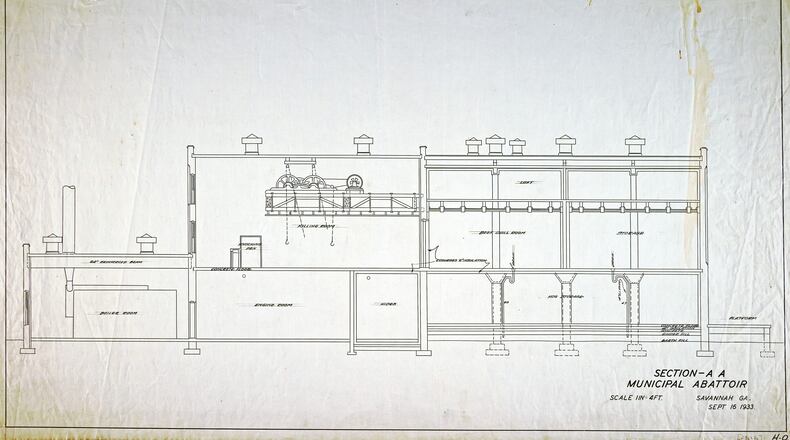Just in time for Thanksgiving, the Municipal Archives brings you the history of the Municipal Abattoir, the official city slaughterhouse. It might seem strange to citizens today, but a municipal abattoir was an important public service offered by many municipalities in the early to mid-20th century, meant to protect the quality of meat sold at local markets.
The construction of municipal slaughterhouses in American cities was a response to the Federal Pure Food and Drug Act of 1906, which did not require that meat rendered for sale in a local market be inspected at all. By operating their own abattoirs, hiring their own inspectors, and passing their own regulatory ordinances, cities could ensure that meat met high sanitary processing standards before it was sold.
Credit: Savannah Municipal Archives
Credit: Savannah Municipal Archives
Savannah’s Municipal Abattoir was built by the Savannah Abattoir and Packing Company in 1917, the same year that the city passed an ordinance outlining the inspection criteria and fees required to operate as a designated municipal slaughterhouse. The 1917 Mayor’s Annual Report discussed the excitement around the new facility: “The new system of inspection will result in a great improvement in the quality of the meat supply, a guarantee of its freedom from disease and contamination, and from dirty slaughter pens and rough handling during transportation.”
The city’s Municipal Abattoir was located on Louisville Road outside of the city limits, near the current intersection with Interstate 516, next to railroad tracks. Although the abattoir was a symbol of a modern, progressive city and its operation was critical to a sanitary community, most residents still preferred that it be out of sight and smell, while still allowing for the easy transport of meat into the City Market.
In 1922, Savannah adopted an ordinance based on the Georgia State Code that allowed the government to “lease, acquire, own, hold, or operate a Municipal Abattoir” and shortly thereafter the Savanah Abattoir and Packing Company, then operated by the Meddin Brothers, petitioned for City Council to rent their facility for $7,500 per year.
After 1922, that facility became the Municipal Abattoir and its performance was reported in the annual Mayor’s Report. The Municipal Abattoir remained in operation at least through 1945 and the Meddin Brothers Packing Company operated the facility until at least 1955.
Credit: Savannah Municipal Archives
Credit: Savannah Municipal Archives
Architectural plans in the Municipal Archives’ Engineering Department collections, as well as documentation on the Sanborn Fire Insurance Maps, give a detailed picture of operations at the facility, showing the various chill rooms, sausage coolers, and even a diagram of the mechanical machinery.
Today, the abattoir operated by the Meddin Brothers remains partially intact and is home to SCAD’s Savannah Film Studios, formerly called Meddin Studios in homage to the building’s history.
City of Savannah Municipal Archives, Archives@savannahga.gov, Discover the Archives: savannahga.gov/MunicipalArchives.
This article originally appeared on Savannah Morning News: Savannah Archives: Municipal Abattoir, a city-run slaughterhouse, ensured quality of meat
The Latest
Featured




